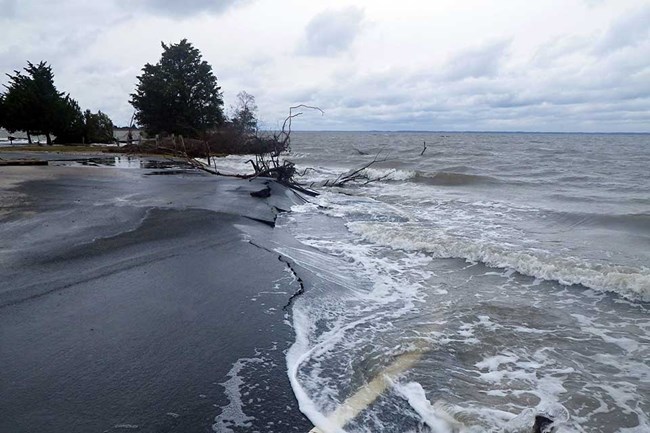
NPS Photo
Along with changes to wind, waves, and currents, sea level rise is changing the physical structure of important coastal landforms and habitats. Sea level rise threatens mainland beaches and rocky shorelines along coasts, where increasing water levels can flood or isolate habitats. Increased flooding of coastal areas can threaten or destroy breeding grounds, nesting areas, and habitats for many marine animals. These animals include sea birds, sea turtles, and even sea lions, which haul-out and pup on low-lying beaches. At Biscayne National Park (Florida) and Buck Island Reef National Monument (Virgin Islands), park scientists are collaborating with non-profit organizations and university researchers to monitor and asses the populations of threatened beach-nesting animals.
In addition to damaging beach habitats and barrier islands, rising seas are allowing saltwater to move into freshwater ecosystems, a process known as “saltwater intrusion,” which can threaten communities of freshwater plants. In Everglades National Park in Florida, freshwater marshes host a diverse array of species that are not adapted to the salty conditions of ocean water, thoughsome of the Everglades’ species actually benefit from the intrusion of saltwater, like the mangrove, which grows in the area where saltwater and freshwater meet. Sea level rise and the increase of salt water that it brings with it allow the mangroves to expand their ranges northward, but this expansion reduces the overall area of freshwater marshes, endangering the survival of these unique freshwater plant communities.
Another problem with sea level rise is that it threatens valuable cultural resources. As sea levels rise, archaeologists and anthropologists must work to preserve coastal cultural history that is in danger of being lost to the encroaching ocean waters. Among the many national parks whose cultural, historical, and archaeological resources are threatened by rising seas is the remote Alaskan Cape Krusenstern National Monument. To learn more about the threatened archaeological resources at Cape Krusenstern, follow the link below.
Due to the variety of ways in which sea level rise can affect coastal parks along the shores of the Atlantic, Pacific, Arctic, and Gulf of America, the National Park Service is researching and monitoring the possible impacts across the nation, using the collected data to improve future planning and decision-making. The parks participating in this research include national seashores such as Assateague Island, Fire Island, and Cape Cod, urban parks such as Golden Gate and Gateway National Recreational Areas, and more remote Pacific parks such as Kaloko-Honokōhau and Kenai Fjords. You can help protect these parks by learning more about the science of sea level rise, educating others, and even participating in local parks’ citizen science efforts.
For more information on sea level rise, explore the links below.
For Further Reading
Changing Landscapes in Assateague Island National SeashoreSea Level Rise in the Everglades
Sea Level Rise and Cape Krusenstern National Monument
Last updated: February 25, 2025
